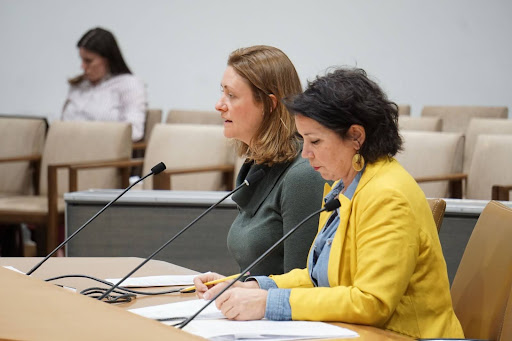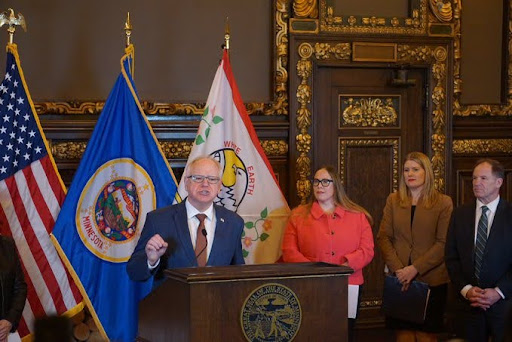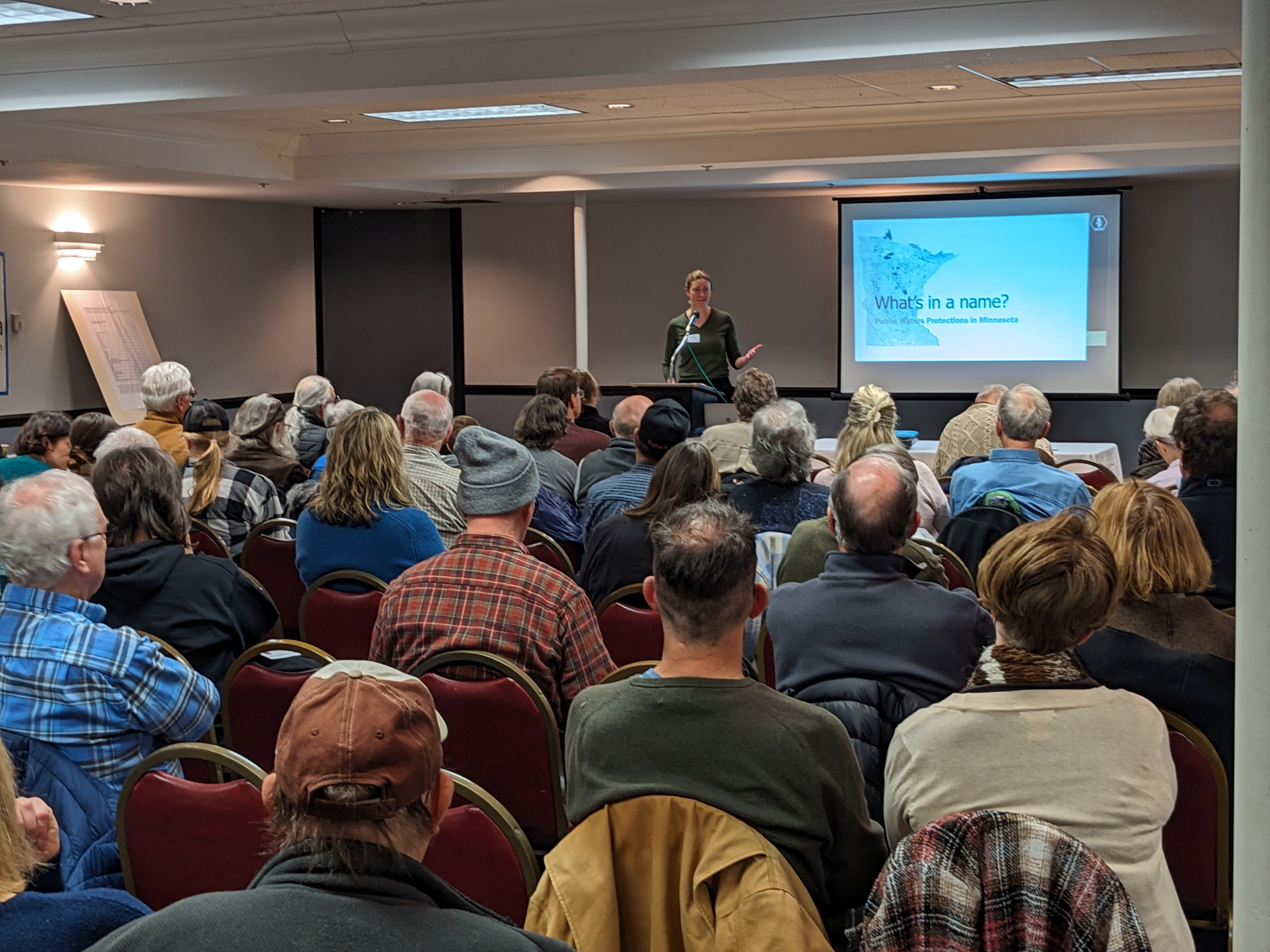Five updates from MCEA's Water Program
.jpeg)
March was a big month for our Water Program.
Here’s what we’ve been up to.
1. Closing the case on Limbo Creek
Photo: erosion along Hawk Creek, a heavily ditched waterway near Limbo Creek
In 2016, a proposal by landowners threatened to convert the last free-flowing stream in Renville County into a straightened ditch that would have increased the velocity and amount of water that flowed into the Minnesota River. This proposal would have cleared and straightened thousands of feet of Limbo Creek, a protected public water.
Ninety percent of the rain that falls in Renville County reaches the Minnesota River within 48 hours, largely due to altered hydrology and artificial drainage. The elimination of wetlands that store water and slow its movement have dramatically changed the landscape. After years of work, in September 2022, the Minnesota Supreme Court affirmed Limbo Creek is a public water and cemented critical protections like mandatory environmental review and permits for activities that impact public waters.
On March 27, the Renville County Drainage Authority approved an alternative plan to install a pump and lift project that will protect our public waters and address the water management needs of farmers. You can read our press release to learn more. This case is an example of how early consultation with all stakeholders could have created a solution much sooner.
“Now that the Limbo Creek matter has been resolved, it’s time for the Legislature to act so that we can avoid similar situations in the future,” says Carly Griffith, Water Program Director at MCEA. “We’re thrilled a resolution was reached that protects water quality while meeting the drainage needs of upstream farms. We hope that clarity from the Legislature can help avoid future disputes.” Thankfully, there is a bill MCEA is supporting (HF3385/SF3558) that would extend the outcome of the Limbo Creek case to all watercourses in Minnesota that meet the statutory definition of public waters.
2. Testifying for Public Waters protections at the legislature

Photo: MCEA Water Program Director Carly Griffith (left) testifying for SF 3558 alongside Sen. Mary Kunesh, author of the bill
When Minnesota became a state, its waters were transferred to the state government to be held in trust for its citizens. And in Minnesota, where water is central to our identity, the legislature has taken an expansive view of what counts as a public water.
There are two key ways that we define “public waters” in Minnesota: Minnesota state law defines public waters and includes “all natural and altered watercourses with a total drainage area greater than two square miles.” There is also a list and map of public waters called the public waters inventory (PWI), which was created in the 1980s by the Department of Natural Resources to document public waters in the state. Currently, the PWI leaves off some waters that meet the definition of public waters in state law, and the process to review and restore waters to the inventory has been painstakingly slow.
This legislative session, a bill was introduced that affirms that the definition of public waters in state law defines the scope of the state's jurisdiction, regardless of whether a watercourse has been correctly identified on the PWI. This is an important step to ensure that all public waters in Minnesota are protected, which is especially critical now that the federal government has narrowed the definition of waters that are protected under federal jurisdiction.
Our Water Program Director Carly Griffith recently testified in favor of the bill in both the house and senate. As Griffith explains, "SF 3558 ensures all public waters in MN are protected. MN has required permits and categories for environmental review that apply when public waters are impacted – but those tools are only effective if all public waters are correctly identified."
Watch Griffith’s testimony to learn more. This bill, HF 3385 (Pursell) / SF 3558 (Kunesh), clarifies that public waters are not exclusively determined by inclusion in or exclusion from the PWI. This is one of MCEA”s bills to watch, and we’ll keep supporting it’s passage through the legislative session.
3. Tracking the response from the state to nitrate contamination in Minnesota’s drinking water

Photo: Governor Walz announcing supplemental budget
Governor Walz announced over four million dollars in the state’s supplemental budget to help address the drinking water crisis in SE Minnesota. With investments like this, our state has the opportunity to lead the Midwest in the response to nitrate pollution in private wells, an entrenched issue in agricultural communities that MCEA has been working on for many years. The response this session is largely in thanks to the hundreds of people who signed on to our petition to the Environmental Protection Agency and their mandate to the state to protect drinking water. Thank you!
There are also two bills we’re supporting at the legislature that address this issue. One is on manure management. Manure contributes to surface and groundwater contamination when it’s overapplied to cropland as a fertilizer. This is especially true in SE Minnesota where the karst geology is like “swiss-cheese” and what’s on the land surface quickly infiltrates into the groundwater and can end up in the prized cold-water trout streams of the region. An important solution to this problem is adequate manure storage capacity, which allows farmers to follow state recommendations for how much manure to apply and when to minimize risks of runoff.
HF 3493 / SF 3527 is legislation that would create a grant program that would provide cost share assistance for manure management and storage facilities for operators that agree to follow best practices for the land application of manure. The program would include dry storage options that have both climate and water quality benefits. It would also include karst feature buffers and conservation easements to limit the agricultural use of vulnerable land.
The second bill is Permanent Funding for Private Well Mitigation (HF 4135). State agency data shows that 16% of wells and springs tested across SE Minnesota exceed the federal human health limit for nitrate. In some townships, over 40% of private wells tested are above the health limit. Unlike those on public water systems, private well owners don’t have any regulatory protections to support them when their water supply is contaminated. Instead, it’s up to private well owners to decide whether to test their water supply, and whether to treat their water if it’s contaminated. Treatment options can be expensive, from approximately $3,000 for the installation and maintenance of reverse osmosis systems to around $30,000 to dig a new well.
HF 4135 creates a $0.99 / ton fee (less than 0.25% of the current cost) on nitrogen fertilizers, which would generate approximately $3 million per year. This would establish a permanent account and funding source for the mitigation of thousands of private wells in Minnesota that have unsafe drinking water because of nitrate contamination. Read our testimony for the bill.
3. Co-hosting the State of the Minnesota River town hall in Mankato

Photo: MCEA Water Program Director Carly Griffith addresses the crowd at the town hall event.
On March 23rd, several advocacy groups hosted a town hall style event in Mankato to talk about the health of the Minnesota River. More than 70 people came to learn from experts about everything from PFAS to the impacts of agricultural drainage tile.
The event was hosted by CURE, Lake Pepin Legacy Alliance, and MCEA with support from the Minnesota Division of the Izaak Walton League, Friends of the Minnesota Valley, Coalition for a Clean Minnesota River, Minnesota Well Owners' Organization, and Freshwater. So much of our work is possible because of partnerships between organizations that care about our environment and individuals who are willing to take time out of their busy lives to protect Minnesota’s environment for future generations. Thank you to all of the partners we work with to protect the Minnesota River Basin!
5. Welcoming our new Program Associate, Akilah Sanders-Reed

Photo: Akilah Sanders-Reed, MCEA Program Associate
We’re excited to welcome Akilah Sanders-Reed to MCEA. Our new Program Associate works across programs, with a focus on water and climate, and brings a wealth of experience in community organizing and nonprofit operations.
Sanders-Reed and the MCEA team first met in 2017, when she was fighting against the construction of the Line 3 tar sands oil pipeline. She was a member of the Youth Climate Intervenors, an unaffiliated group of young people who won the right to participate in the administrative hearing for the Line 3 project as an official “party” on the basis that the extraction of more tar sands oil would exacerbate the dangerous climate crisis already threatening our health and well-being. MCEA staff attorneys served as Youth Climate Intervenors’ legal counsel in 2018 when the case moved from the Public Utilities Commission to the Minnesota Court of Appeals. Read more about the case.
Join us in welcoming Sanders-Reed back to MCEA as a staff member. In addition to the passion and perspective she brings to protecting Minnesota’s environment she’s ready to add even more momentum in the organization. “I get excited about building the technical analysis and internal structures that help our movements scale up to realize tangible wins,” she says. To which we say, let’s go!